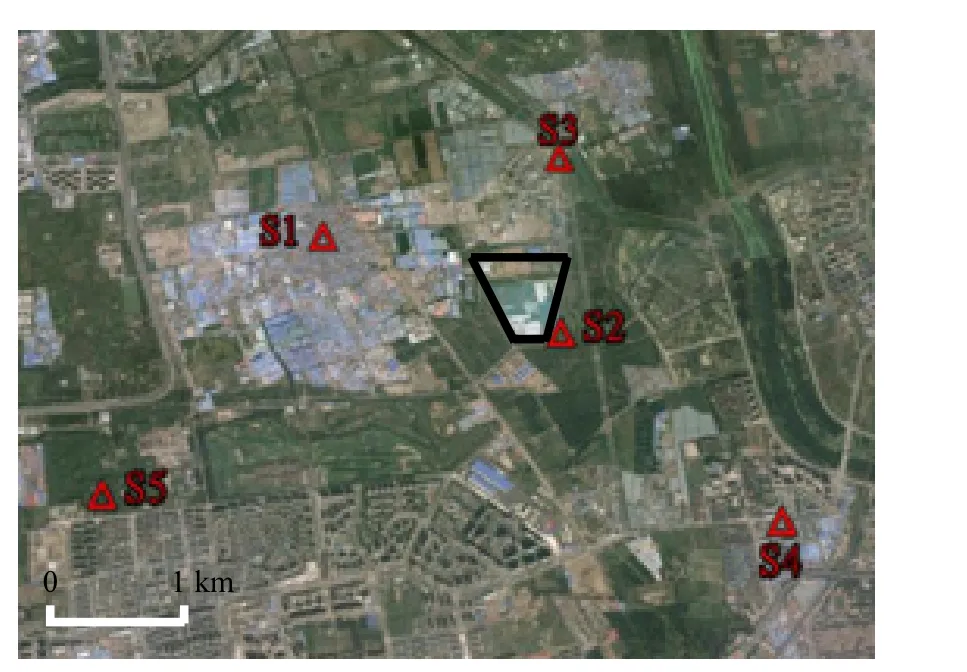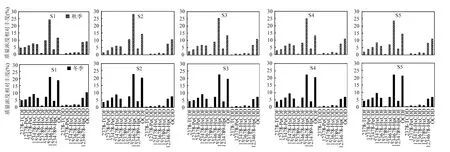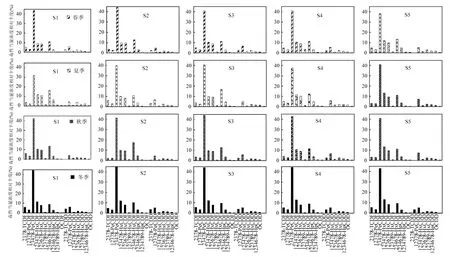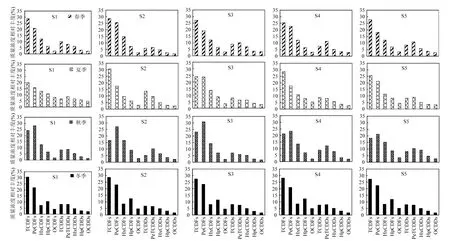垃圾焚烧厂周边大气二含量及变化特征
—以北京某城市生活垃圾焚烧发电厂为例
齐 丽,任 玥,李 楠,郑 森,赵 虎,范 爽,周志广,许鹏军,刘爱民,张 烃,黄业茹 (国家环境分析测试中心,国家环境保护二污染控制重点实验室,北京 100029)
齐 丽*,任 玥,李 楠,郑 森,赵 虎,范 爽,周志广,许鹏军,刘爱民,张 烃,黄业茹 (国家环境分析测试中心,国家环境保护二污染控制重点实验室,北京 100029)
摘要:2013年4月至2014年1月对北京市某生活垃圾焚烧厂周边4km范围内5个采样点环境空气中二含量、组成特征及季节变化特征进行了分析.结果表明该垃圾焚烧厂周边环境空气中PCDD/Fs质量浓度的变化范围为8.3~115pg/m3,毒性当量(TEQ)变化范围为0.11~1.9pg I-TEQ/m3,其中秋季1个采样点和冬季全部采样点超出日本环境空气质量标准限值(0.6pg I-TEQ/m3).1,2,3,4,6,7,8-HpCDF和OCDF均是四季空气中PCDD/Fs质量浓度的主要贡献单体,而2,3,4,7,8-PeCDF是总TEQ贡献最大的单体.空间分布特征表现为近源点位(~400m)浓度水平较高而其他点位(>1000m)浓度水平与距污染源距离远近没有显著相关性;季节变化特征表现为冬季值显著高于其他季节,分析可能与冬季采暖及大气扩散条件差导致的大气整体污染较重有关.样品中二同族体及异构体分布指纹谱图与焚烧设施排放烟气存在差别,主成分分析(PCA)源解析结论与指纹谱图特征分析结论一致,体现为多种污染源共同作用的影响.二呼吸暴露剂量估算结果表明该区域人群呼吸暴露风险总体处于较为安全的水平(0.034~0.161pg I-TEQ/(kg⋅d)),但仍需关注大气重污染天气发生时的呼吸暴露风险.
关键词:生活垃圾焚烧;环境空气;二;季节变化;主成分分析;呼吸暴露
* 责任作者, 高级工程师, ql_cneac@163.com
多介质归趋模型模拟研究表明:大气传输和从空气相—土壤(水)相干湿沉降是二类在环境中的主要迁移途径[1-3],即排放至大气中的二类通过和各个环境介质间的相间迁移,在全球范围内分布并进入食物链,危害生态系统和人体健康[4-6].大气中的二主要来自金属冶炼、废弃物焚烧等人类生产活动[7-11],其中生活垃圾焚烧排放是城市地区大气二来源的最重要途径之一.自Olie等[12]首次发现城市生活垃圾焚烧的烟气和飞灰中存在二以来,许多国家和地区对城市生活垃圾焚烧厂二排放的环境影响进行了深入的科学研究[7,13-18].研究表明大部分生活垃圾焚烧厂周围大气中的二分布与生活垃圾焚烧厂废气二的排放浓度成正比[19-20].如Oh等[21]对韩国某生活垃圾焚烧厂1999~2006年的跟踪监测表明周边大气中二浓度水平在采用烟气净化装置前后明显降低,推断此生活垃圾焚烧厂周围大气主要受该垃圾焚烧厂的影响.我国对垃圾焚烧厂周边大气中二含量水平的研究起步相对较晚,目前仅有少量研究报道.如徐梦侠等[22]对杭州市某垃圾焚烧厂周边环境介质中二的分布规律进行研究,发现规范运行的垃圾焚烧排放对周边环境空气二浓度的影响有限.除污染源外,不同的气候也是影响大气二浓度水平及其行为特征的重要因素[23].由于季节的交替伴随着主导风向、温度、干湿沉降等因素的改变,研究大气中二的浓度与季节变化的关系,一方面可以揭示其来源问题[24],另一方面也反映二在大气中的某种亏损过程或去向问题.
北京作为国家经济金融的决策中心和管理中心,随着经济的高速持续增长,城市规模不断扩大和人民生活水平的迅速提高,城市生活垃圾的产生量急剧增加.除卫生填埋外,垃圾焚烧已逐渐发展成为一种重要的垃圾处理方式.考虑到垃圾焚烧产生的二次污染物如二等可能对周边环境及居民的健康造成负面影响,此处理方式一度受到公众的强烈反对.因此,本研究选取北京市某大型垃圾焚烧发电厂周边环境作为研究区域于2013年至2014年不同季节开展共计四次监测,综合评价其周边环境空气中二类污染物的含量、组成及分布规律,以及周边人群经呼吸途径的二类暴露水平,探讨该设施二排放对周边地区可能造成的环境影响及健康风险,为环境管理部门有效开展垃圾焚烧处理提供技术支持.
1 材料与方法
1.1 研究区域及样品采集
生活垃圾焚烧发电厂设计垃圾处理规模为1600t/d,安装有800t/d×2炉排炉以及烟气处理系统(脱酸塔+活性炭喷射+布袋除尘器).以厂区(图1中梯形区域所示)为中心,采用同心圆布点法力求覆盖各方位的原则,并根据周边居民分布情况,在周边4km范围内不同方位选取4个居民聚集区(S1、S3~S5)和1个厂界区(S2)进行环境空气二监测,各采样点距污染源的距离分别约为1.8、0.4、1.4、2.7和3.6km.采样仪器均设置于开阔院落地面上,周边15m内无较大障碍物,分别位于排放源的东北、东南、西北、西南方向及厂区边界.各采样点位置如图1所示.

图1 环境空气采样布点示意(梯形区域为厂区)Fig.1 Ambient air sampling sites around the MSWI
1.2 样品前处理、分析及质控
空白加标的检出结果均低于检出限,所有样品在分析过程添加的PCDD/Fs标记物的回收率均处于35%~115%之间,符合HJ77.2-2008的质量控制要求.在数据处理过程中,低于检出限的目标污染物质量浓度以0计算.
2 结果与讨论
5个采样点四期监测得到的大气PCDD/Fs浓度如表1所示,其4~8氯代PCDD/Fs同族体总浓度范围为8.3~115pg/m3,各采样点季平均值为24.7~52.7pg/m3,17种2,3,7,8位取代的PCDD/Fs毒性当量浓度范围为0.11~1.9pg I-TEQ/m3,季平均值为0.40~0.77pg I-TEQ/m3.除冬季监测数据外,其余各采样点监测结果基本与之前报道的城市环境空气PCDD/Fs含量水平相当:北京市区(2006年0.268pg I-TEQ/m3;2011- 2012年0.251pg I-TEQ/m3)[26-27]、广州市区(0.364pg I-TEQ/m3)[28]及上海市区(0.268pg I-TEQ/m3)[29], 除S2采样点秋季监测结果达到被Fielder等[30]定义为受点源污染的标准范围(0.350~1.60pg I-TEQ/m3)外,其余点位均在Lohmann等[23]提出的城市环境空气中二标准浓度范围0.100~0.400pg I-TEQ/m3之内.与日本规定的空气PCDD/Fs的年均值标准(0.6pg I-TEQ/m3)[31]相比较,S2采样点秋季监测结果略高于此排放限值,而冬季各采样点均超出该标准限值83%~ 217%.
从分布情况可知,近源采样点S2(<1000m)在各采样期二浓度水平较高,表明厂界区域可能受到此垃圾焚烧设施的影响相对高于其他采样点.风向是影响排放源二扩散的最基本因素.本研究中,由于采样时段涵盖一年四季,北京冬季主导风向为西北方向;夏季主导风向为东南方向;春秋季多为西北风,各期采样期间气象条件:风力小于三级,风向为无持续风向天气,天气以晴或晴间多云为主(www.bjmb.gov.cn).因此,非近源采样点在主导风向上、下风向的浓度差异不明显.张振全等[32]对华南某工业区垃圾焚烧设施周边环境空气中PCDD/Fs含量研究发现点源烟气的影响存在“灯下黑”的特点,即下风向最大落地浓度点位置(距离源一般1km左右)附近含量较高.本研究中S1采样点夏季位于主导风向的下风向且与污染源距离接近最大落地浓度点位置,但其在夏季浓度略低于其他采样点,表明除近源区域外该垃圾焚烧发电厂排放对周边的影响不显著.

表1 各采样点大气中PCDD/Fs总质量浓度(pg/m3)及毒性当量浓度(pg I-TEQ/m3)Table 1 Mass and TEQ concentrations of PCDD/Fs in the samples at each sampling site
从表1可见,各采样点最高值均出现在冬季,最低值均出现在春季,其次是夏季和冬季.各点位不同季节PCDD/Fs平均浓度高低顺序为冬季(85.2pg/m3)>秋季(32.4pg/m3)>夏季(18.6pg/m3)>春季(12.6pg/m3);二毒性当量浓度的季节变化也遵循相同的规律,即冬季(1.4pg I-TEQ/m3)>秋季(0.41pg I-TEQ/m3)>夏季(0.20pg I-TEQ/m3)>春季(0.16pg I-TEQ/m3).这与天津、香港等地城市冬季大气二浓度水平最高相似[33-34],而与广州地区春季大气二明显高于秋、冬、夏三季不同[35].
2.3 PCDD/Fs毒性异构体分布特征
PCDD/Fs的17种毒性异构体分布特征是重要的指纹特性之一,常用作最基本的溯源分析,可以采用单体对总质量浓度的贡献率和单体对总毒性当量浓度的贡献率进行表述.
2.4 PCDD/Fs同族体分布特征
2.5 多变量来源分析
为进一步了解焚烧设施周边环境空气中PCDD/Fs与垃圾焚烧源的关系,应用主成分分析方法(PCA)对典型排放源烟气和空气样品之间PCDD/Fs的17种2,3,7,8-位取代二异构体特征相似度进行了分析.调研发现周边除垃圾焚烧设施外重要的热排放源还有无组织燃煤锅炉、殡葬焚烧厂和交通源等.为了分辨多种源对环境空气的影响,对采集样品和典型城市大气二排放源17种异构体相对丰度进行主成分分析(PCA),主要包括生活垃圾焚烧厂烟气、燃煤锅炉烟气、殡仪馆火化机烟气、汽油机动车尾气和柴油机动车尾气等(注:由于缺乏本地数据,燃煤锅炉及汽(柴)油车参考U. S. EPA二排放源数据库[39],殡仪馆及生活垃圾焚烧烟气二数据为排放源实测数据).
图6显示了以不同季节采样点样品为变量的主成分分析结果,提取2个主成分因子,因子1和因子2分别解释44.2%和22.4%的总方差.二异构体谱图类似的相距较近,反之较远.从图6可知,5个采样点四季的结果分布集中,说明研究区域大气中的二异构体分布特征相似,细微差别可能由各采样点不同季节周边具体活动程度及微气象条件差异所致,这也从各采样点结果在每个季节更为靠近得到佐证.环境空气中的二来源较广,除焚烧排放源外,所有采样点特征谱图与燃煤锅炉和汽油机动车相距更近,表明研究区域可能同时受到这3种源共同作用且受到燃煤锅炉和交通源的影响更大.另外,冬季西北主导风向的下风向(S4和S5)采集的空气样品中二毒性当量与上风向(S1和S3)相当,进一步说明焚烧源烟气排放通过扩散迁移对环境空气中的二贡献率较小;较高浓度的二来源较为复杂,并非受该生活垃圾焚烧设施烟气排放的主导影响.PCA的分析结果与上文提及的各采样点异构体和同族体分布特征指纹谱图与生活垃圾焚烧烟气二谱图存在一定差异的分析结果一致.


图2 各点位17种2,3,7,8-位取代PCDD/Fs单体占总质量浓度的相对丰度Fig.2 Relative abundance of 2,3,7,8-substituted PCDD/Fs congeners in the samples at each sampling site

图3 各点位17种2,3,7,8-位取代PCDD/Fs单体占总毒性当量浓度的相对丰度Fig.3 Relative I-TEQ abundance of 2,3,7,8-substituted PCDD/Fs congeners in the samples at each sampling site

图4 焚烧厂烟气2,3,7,8-PCDD/Fs异构体质量浓度、毒性当量及四~八氯代同族体质量浓度相对丰度Fig.4 Relative contributions of individual congener and homologue to the total mass and TEQ of PCDD/Fs in flue gas


图5 各点位PCDD/Fs同族体分布特征谱图Fig.5 PCDD/Fs homologue profiles of the samples at each sampling site
式中:IPad/ch指经呼吸二暴露量(pg I-TEQ/ (kg⋅d));Cair为空气中PCDD/Fs浓度水平(pg I-TEQ/m3),取每个采样点四季采样监测的浓度均值;Vrad/ch指吸入速率(m3/d),取《中国人群环境暴露行为模式研究报告(成人卷)》和《中国人群暴露参数手册(成人卷)》中推荐的吸入速率值0.25m3/(kg⋅d),儿童取值0.51m3/(kg⋅d);ƒr指肺中停留系数,成人和儿童取均值0.75,Wad/ch指人体体重,成人取我国居民成人平均体重60.6kg, 儿童取15kg;(Nso,ad/ch+ Nwo,ad/ch+ Nsl,ad/ch+ Nwi,ad/ch+ Nsi,ad/ch)指肺中停留时间,取美国EPA推荐的估算值,成人0.457,儿童0.616.

图6 排放源与环境空气中PCDD/Fs相关性分析(采样点名称指代季节+点位)Fig.6 Correlation of PCDD/Fs profiles in emission sources and air samples
3 结论
3.1 生活垃圾焚烧厂周边大气中PCDD/Fs质量浓度和毒性当量浓度的变化范围分别为8.3~ 115pg/m3和0.11~1.9pg I-TEQ/m3,其中1,2,3,4,6, 7,8-HpCDF和OCDF是四季环境空气中PCDD/Fs质量浓度的主要贡献单体,2,3,4,7,8-PeCDF是总TEQ贡献最大的单体.
3.5 对焚烧厂周边区域人群的PCDD/Fs呼吸暴露剂量的估算结果表明其处于较为安全的水平,但大气重污染季节的呼吸暴露风险应该得到足够的重视.
参考文献:
[1] Noriyuki S, Masashi Y, Takeo S, et al. Model simulation of environmental profile transformation and fate of polychlorinated dibenzo-p-dioxins and polychlorinated dibenzofurans by the multimedia environmental fate model [J]. Chemosphere, 1998, 37(9-12):2239-2250.
[2] Noriyuki S, Masashi Y, Takeo S, et al. Simulation of long-term environmental dynamics of polychlorinated dibenzo-p-dioxins and polychlorinated dibenzofurans using the dynamic multimedia environmental fate model and its implication to the time trend analysis of dioxins [J]. Chemosphere, 2000,40(9-11):969-976.
[3] Zhang Baoning, Meng Fan, Shi Chune, et al. Modeling the atmospheric transport and deposition of polychlorinated dibenzop-dioxins and dibenzofurans in North America [J]. Atmos. Environ., 2009,43(13):2204-2212.
[4] Tusscher G, Koppe J. Perinatal dioxin exposure and later effects-a review [J]. Chemosphere, 2004,54(9):1329-1336.
[5] Hertz-Picciotto I, Charles M, James R, et al. In utero polychlorinated biphenyl exposures in relation to fetal and early childhood growth [J]. Epidemiology, 2005,16(5):648-656.
[6] Nakajima S, Saijo Y, Kato S, et al. Effects of prenatal exposure to polychlorinated biphenyls and dioxins on mental and motor development in Japanese children at 6months of age [J]. Environ. Health Perspect., 2006,114(5):773-778.
[7] Ulrich Q, Micheal F, Gunter B, et al. The European dioxin air emission inventory project-final results [J]. Chemosphere, 2004, 54:1319-1327.
[8] Lee W, Chang G, Wang L, et al. Source identification of PCDD/Fs for various atmospheric environments in a highly industrialized city [J]. Environ. Sci. and Technol., 2004,38(19):4937-4944.
[9] 蒋李萍,林 鹿,邱玉桂,等.环境中二类物质的来源与降解途径 [J]. 环境科学与技术, 2004,27(1):94-96.
[10] 陆 勇,田洪海,周志广,等.电弧炉炼钢过程中二类的排放浓度和同类物分布 [J]. 环境科学研究, 2009,22(3):304-308.
[11] 李艳静,张素坤,冯桂贤,等.两种典型生活垃圾焚烧炉烟气中二相态分布特征 [J]. 中国环境科学, 2011,31(10):1632-1636.
[12] Olie K, Vermeulen R, Hutzinger O. Chlorobenzo-p-dioxins and chlorobenzo-furans are trace components of fly ash and flue gasof some municipal incinerators in the Netherlands [J]. Chemosphere, 1977,6:455-459.
[13] US EPA. An inventory of sources and environmental releases of dioxin-like compounds in the United States for the years 1987, 1995 and 2000 [M]. Washington D. C.: US Press, 2006.
[14] Unep. Dioxin and furan inventories-national and regional emissions of PCDD/Fs [M]. Geneva: UNEP Chemicals, 1999.
[15] Tian, Honghai, OU, Yangne. Preliminary investigation on dioxins emission from MSW incinerators [J]. Environ. Chem., 2003,22: 255-258.
[16] Shih T, Chen H, Wu Y, et al. Exposure assessment of polychlorinated dibenzo-p-dioxins and dibenzofurans (PCDD/Fs) in temporary municipal-waste-incinerator maintenance workers before and after annual maintenance [J]. Chemosphere, 2006,64: 1444-l449.
[17] Yan Jianhua, Chen Tong, LI Xiaodong, et al. Evaluation of PCDD/Fs emission from fluidized bed incinerators co-firing MSW with coal in China [J]. J Hazard. Mater., 2006,35:47-51.
[18] Ni, Yuwen, Zhang Haijun, Fan Su, et al. Emissions of PCDD/Fs from municipal solid waste incinerators in China [J]. Chemosphere, 2009,75:1153-1158.
[19] Abad E, Caixach J, Rivera J. PCDD/PCDF from emission sources and ambient air in Northeast Spain [J]. Chemosphere, 1997,35: 453-463.
[20] Caserini S, Cemuschi S, Giugliano M, et al. Air and soil dioxin levels at three sites in Italy in proximity to MSW incineration plants [J]. Chemosphere, 2004,54(9):1279-1287.
[21] OH J, CHOI S, LEE S, et al. Influence of a municipal solid waste incinerator on ambient air and soil PCDD/Fs levels [J]. Chemosphere, 2006,64:579-587.
[22] 徐梦侠.城市生活垃圾焚烧厂二排放的环境影响研究 [D].杭州:浙江大学, 2009.
[23] Lohmann R, Jones K. Dioxins and furans in air and deposition: A review of levels, behaviour and processes [J]. Sci. Total Environ., 1998,219(1):53-81.
[24] Hippelein M, Kaupp H, DÖRR G, et al. Baseline contamination assessment for a new resource recovery facility in Germany part II: atmospheric concentrations of PCDD/F [J]. Chemosphere, 1996,32(8):1605-1616.
[25] 环境保护部.HJ77.2—2008 环境空气和废气 二类的测定 同位素稀释高分辨气相色谱-高分辨质谱法 [S]. 北京:中国环境科学出版社, 2009.
[26] LI Yingming, JIANG Guibin, WANG Yawei, et al. Concentrations, profiles and gas-particle partitioning of polychlorinated dibenzop-dioxins and dibenzofurans in the ambient air of Beijing, China [J]. Atmos. Environ., 2008,42:2037-2047.
[27] ZHOU Zhiguang, ZHAO Bin, QI Li, et al. Distribution of polychlorinated-p-dioxins and dibenzofurans in the atmosphere of Beijing, China [J]. Aerosol Air Qual. Res., 2014,14:1269-1278.
[28] YU Liping, MAI Bixian, MENG Xiaojun, et al. Particle-bound polychlorinated dibenzo-p-dioxins and dibenzofurans in the ambient air of Guangzhou, China [J]. Atmos. Environ., 2006,40: 96-108.
[29] LI Huiru, FENG Jialiang, SHENG Guoying, et al. The PCDD/F and PBDD/F pollution in the ambient atmosphere of Shanghai, China [J]. Chemosphere, 2008,70:576-583.
[30] Fiedler H. Sources of PCDD/Fs and impact on the environment [J]. Chemosphere, 1996,32:55-64.
[31] Environmental quality standards in Japan: air quality [EB/OL]. http://www.env.go.jp/en/air/aq/aq.html.
[32] 张振全,张漫雯,赵保卫,等.生活垃圾焚烧厂周边环境空气中PCDD/Fs含量及分布特征 [J]. 中国环境科学, 2013,33(7): 1207-1214.
[33] Ding Lei, Li Yingming, Wang Pu, et al. Seasonal trend of ambient PCDD/Fs in Tianjin City, northern China using active sampling strategy [J]. J Environ. SCI-China, 2012,24(11):1966-1971.
[34] Sin D, Choi J, Louie P. A study of polychlorinated dibenzo-pdioxins and dibenzofurans in the atmosphere of Hongkong [J]. Chemosphere, 2002,47(6):647-653.
[35] 苏 原,张素坤,任明忠,等.广州大气二污染水平及其季节变化特征 [J]. 环境科学研究, 2014,27(8):813-819.
[36] Wang J, Wang M, Wu E, et al. Approaches adopted to assess environmental impacts of PCDD/F emissions from a municipal solid waste incinerator [J]. J Hazard. Mater., 2008,152:968-975.
[37] Chen Tong, Li Xiaodong, Yan Jianhua, et al. Distribution of polychlorinated dibenzo-p-dioxins and dibenzofurans in ambient air of different regions in China [J]. Atmos. Environ., 2011,45: 6567-6575.
[38] Wagrowski D, Hites R. Insights into the global distribution of polychlorinated dibenzo-p-dioxins and dibenzofurans [J]. Environ. Sci. and Technol., 2000,34(14):2952-2958.
[39] US EPA. Database of Sources of Environmental Releases of Dioxin like compounds in the United States [R]. EPA/600/C-01/012,2001.
[40] Nouwen J, Cornelis C, FRÉ D, et al. Health risk assessment of dioxin emissions from municipal waste incinerators: the Neerlandquarter (Wilrijk, Belgium) [J]. Chemosphere, 2001,43: 909-923.
[41] 胡习邦,许振成,王俊能,等.环境介质中PCDD/Fs人群健康风险评价—以珠江三角洲为例 [J]. 生态环境学报, 2011,20(2): 311-316.
[42] 环发2008[82]号 关于进一步加强生物质发电项目环境影响评价管理工作的通知 [Z].
Concentrations, spatial and seasonal variations of PCDD/Fs in ambient air around a municipal solid waste incinerator—a case study in Beijing.
QI Li*, REN Yue, LI Nan, ZHENG Sen, ZHAO Hu, FAN Shuang, ZHOU Zhi-guang, XU Peng-jun, LIU Ai-min, ZHANG Ting, HUANG Ye-ru (State Environmental Protection Key Laboratory of Dioxin Pollution Control, National Research Center for Environmental Analysis and Measurement, Beijing 100029, China). China Environmental Science, 2016,36(4):1000~1008
Abstract:The concentrations, profiles and seasonal variations of PCDD/Fs in ambient air around a municipal solid waste incinerator (MSWI) in Beijing from April 2013 to January 2014 were investigated. The mass concentrations and TEQ of 2,3,7,8-substituted PCDD/Fs in the air samples ranged from 8.3 to 115pg/m3and from 0.11to 1.9pg I-TEQ/m3, respectively. The concentration values at 1sampling site in autumn and all 5sampling sites in winter were higher than the ambient air standard of 0.6pg I-TEQ/m3for dioxins regulated in Japan. 1,2,3,4,6,7,8-HpCDF and OCDF dominated PCDD/Fs in all the samples for all four seasons, while 2,3,4,7,8-PeCDF was the dominant congener contributing to TEQ. The spatial distribution basically exhibited a trend that the concentrations at site close to the MSWI (~400m) are higher whereas those at other sites (>1000m) are comparable and not related to the distances from the source. Seasonal variation showed obviously higher concentration in winter than the other three seasons, which may attribute to domestic heating and worse atmospheric dispersion that occur in winter. The homologue and congener profiles of PCDD/Fs in the air samples differed from those of the flue gas emission from the MSWI, consistent with the principal component analysis results, indicating that the concentrations of PCDD/Fs in ambient air were not affected by the MSWI exclusively, but jointly influenced by multiple sources. Dioxin inhalation exposure dose estimation showed that the dioxin inhalation exposure risk of residents living in the studied area was at a relative safe level (0.034~0.161pg I-TEQ/(kg⋅d)). However, the dioxin inhalation exposure risk in heavily polluted seasons still needed great concerns.
Key words:MSWI;ambient air;PCDD/Fs;seasonal variation;principal component analysis;inhalation exposure
作者简介:齐 丽(1980-),女,河北邢台人,高级工程师,博士,主要从事二类及有机气溶胶研究.发表论文20余篇.
基金项目:国家重点基础研究发展计划(973计划)项目(2015CB453101)
收稿日期:2015-08-30
中图分类号:X510.2,X831 文献识别码:A
文章编号:1000-6923(2016)04-1000-09

